Living in Florida and saw some big birds but are not sure which ones they were?
Florida is known for its wildlife, and according to the Florida Ornithological Society Records Committee (FOSRC), there are over 500 species of birds there. And just like Michigan’s and Texas’ birds, there is plenty of those that grew up to impressive sizes.
The list of big birds in Florida includes Caspian terns, great horned owls, whooping cranes, great blue herons, great egrets, bald eagles, black and turkey vultures, and many others.
The largest bird in Florida is the American white pelican with a length of 70 inches and a wingspan of 120 inches.
The only bird that is bigger in entire North America is the California condor which isn’t found in FL.
Some of these Florida’s enormous birds, like the wood stork, great horned owl, and the bald eagle can be seen year-round in the state, while others, like the American white pelicans, will spend only winters there.
To decide which bird is bigger, we will look at its length and its wingspan.
Table of Contents
Big Birds In Florida
American White Ibis

Scientific name: Eudocimus albus
Lifespan: 16 years in the wild
Wingspan: 35-41 in
Length: 21-28 in
Weight: 1.3-2.7 lb
Range In Florida: Year-round resident throughout Florida
American white ibises are wetland birds that are native to Florida.
They have all-white plumage and black wing tips seen during flight. They also have very long legs, pink facial skins, and long necks held straight in flight.
American white ibises have bright red-orange downcurved beaks that become pink with black tips during the breeding season.
White ibises are one of the most numerous wading birds in Florida and can be seen there throughout the year as they are permanent residents. They inhabit shallow coastal marshes, wetlands, mangrove swamps, and even parks and golf courses.
American white ibises make several sounds, including the honking “urnk-urnk” call they use in flight or when agitated, and the muted “huu-huu” call when foraging.
They are very social birds with some colonies including over 30,000 birds. In Florida, they breed during spring and summer, females lay between two and four eggs, and both parents take turns in incubating the eggs.
One field study in Florida discovered that white ibises spent around 10 hours a day looking for food, less than an hour flying, and 13 hours resting and roosting.
They are carnivores and consume crabs, crayfish, fish, snakes, frogs, and insects that they find by probing the ground with their long beaks.
White ibises are protected by the U.S. Migratory Bird Treaty Act – it is illegal to hunt them.
Limpkin

Scientific Name: Aramus guarauna
Lifespan: n/a
Wingspan: 40-42 in
Length: 25-29 in
Range In Florida: Year-round resident in Central, Southern, and Northern Florida (without the Panhandle)
Limpkins are large wading birds that are native to Florida.
They can be identified by their large necks, curved beaks, and heavy bodies; they weigh almost 3 pounds.
Males are larger than females, but both sexes look alike. They are mostly brown and have white spots and streaks that are densest on their heads and necks. Their beaks are slightly open closer to the mouth but closed at the tip, similar to tweezers, allowing them to grab apple snails with ease.
Limpkins are permanent residents of Florida and can be seen around freshwater marshes and swamps. They nest in the state from February to June. Limpkins will often make loud screaming “klaaar” calls, clucks, piercing “bihks,” etc.
They love to forage in shallow waters, and besides their favorite apple snails, they might also consume some insects, frogs, lizards, worms, and seeds.
Some individuals are monogamous for a season or two. Both partners will take turns in incubating the clutch of 3-8 eggs. Limpkins were named after their slow gait which resembles limping.
Crested Caracara
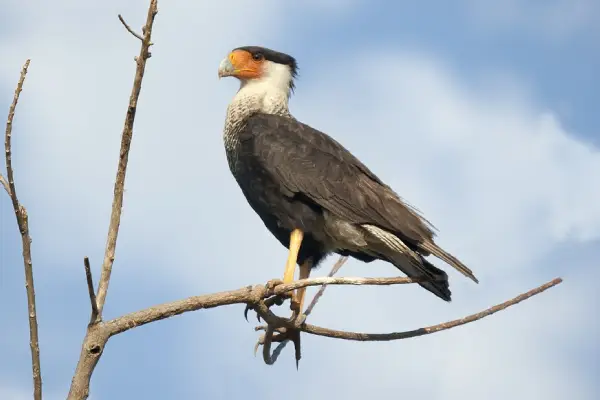
Scientific Name: Caracara cheriway
Lifespan: up to 30 years
Wingspan: 47-52 in
Length: 20-26 in
Weight: 2-3.5 lb
Range In Florida: Central Florida
Native to Florida, crested caracaras are large raptors found around cattle ranches, farms, and fields of the state. They are dark brown overall and have white necks, black caps on their white heads, orange facial skin, and long yellow legs.
Crested caracaras are permanent residents of Central Florida and can be seen there throughout the year. They breed there from September to April; the peak of the breeding season is from January to March.
Although mainly quiet, crested caracaras might make some rattling sounds, like moving a stick along the fence, during the breeding season.
With a length of up to 26 in, a wingspan of up to 52 in, and a weight of up to 3.5 pounds, crested caracaras are the largest falcon species in Florida.
Crested caracaras are opportunistic feeders that eat carcasses, food of other raptors, insects, and some fruit. These white-headed falcons will often chase away black and turkey vultures from roadkills.
Read More: More examples of birds common in Central Florida
Caspian Tern

Scientific name: Hydroprogne caspia
Lifespan: 12 years
Wingspan: 50–57 in
Length: 19–24 in
Weight: 1.1-1.72 lb
Range In Florida: Winter resident throughout most of Florida
The Caspian tern is the largest tern in Florida and the world. It is easy to recognize by its large head, coral red beak, shallowly forked tail, and deep, raspy call. Caspian tern has white color overall with pale gray upperwings.
This large bird got its name from the early associations with the Caspian Sea where Caspian terns are still fairly common.
Caspian terns can be seen in Florida during the cooler months of the year when they migrate after breeding on large lakes and ocean coasts in North America. In some parts of the state, along the northern and central coasts of Florida, these birds can be even found year-round.
They are very aggressive when defending their breeding colony. Caspian terns will pursue, attack, and chase away potential predatory birds, and even bite people on the heads if they invade their space.
Caspian terns will hover high over the water, scanning for fish. When they spot one, they will fly down rapidly and dive to catch it. They also occasionally feed on large insects, the young and eggs of other birds, and some rodents.
Swallow-tailed Kite
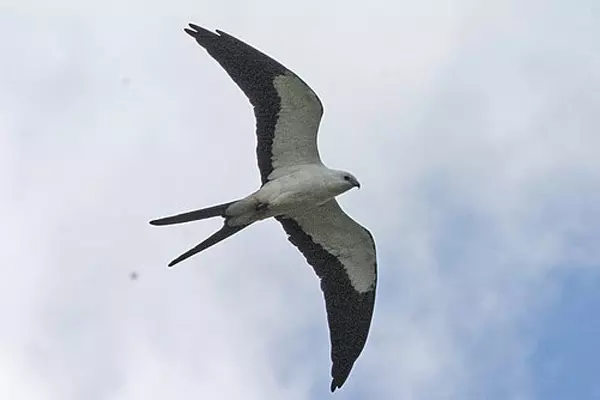
Scientific name: Elanoides forficatus
Lifespan: 6 years
Wingspan: 44-53.5 in
Length: 20-27 in
Weight: 0.7-1.3 lb
Range In Florida: Summer resident throughout Florida
Swallow-tailed kites are also known as American swallow-tailed kites.
These broad-winged (pernine) raptors are the largest kites found in Florida. Common around marshes, fields, farms, wooded, and urban areas of Florida, swallow-tailed kites can be seen in the state from spring to fall.
Look for these Central Florida birds arriving around February/March to breed and departing around August/September. You will recognize them by their white bodies and heads, black and white wings, and unmistakable long and black tails.
With their long wings, deeply forked tail, and bold black-and-white plumage, swallow-tailed kites are very easy to recognize in flight.
They are omnivorous and feed on snakes, lizards, frogs, large insects, small birds, eggs, small mammals, and even some fruit.
Red-tailed Hawk
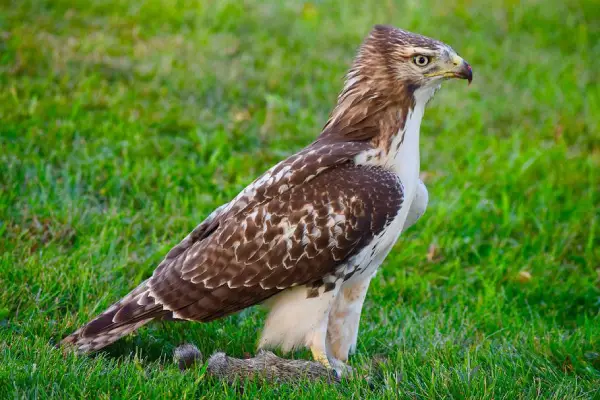
Scientific Name: Buteo jamaicensis
Lifespan: 10-15 years in the wild
Wingspan: 55 in
Length: 18–26 in
Weight: 1.5-3.5 lb
Range In Florida: Year-round resident throughout Florida
Red-tailed hawks are large birds with broad rounded wings and short wide tails. There are several variations of their colors; most are brown with light bellies, streaky breast bands, and rusty tails. Females tend to be larger than males.
Red-tailed hawks are among the largest hawks species found in Florida. These birds of prey can be seen in almost every habitat with open areas and patches of trees or other elevated perches. You will often spot them sitting perched near a roadside or soaring in the sky and looking for prey.
They can spot a mouse from 100 feet in the air and will grab it using their almost inch-and-a-half-long talons. Red-tailed hawks are carnivores that feed on small mammals, especially rodents and rabbits, birds, reptiles, occasionally fish, and large insects.
These raptors are monogamous and will usually nest in hardwood trees, especially black cottonwood or red alder. Red-tailed hawks are legally protected in the United States by the Migratory Bird Treaty Act and you can’t hunt them. There are 14 subspecies of red-tailed hawks.
Wild Turkey
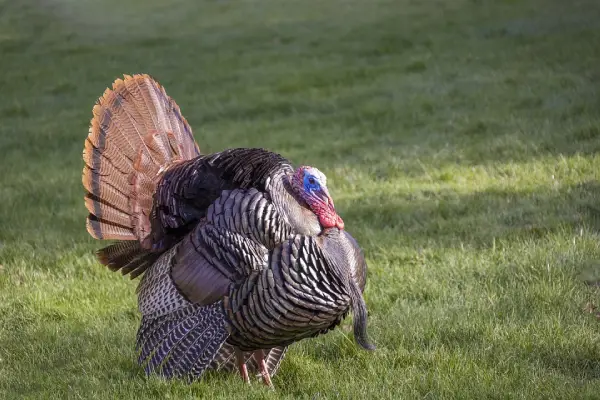
Scientific name: Meleagris gallopavo
Lifespan: 3-5 years in the wild
Wingspan: 49.2-56.7 in
Length: 30-49 in
Weight: 5.5-24 lb
Range In Florida: Year-round resident throughout Florida
Wild turkeys are the largest wild turkey species in Florida.
They are native to North America and are considered to be ancestors of domestic turkeys. They are the main course on Thanksgiving and Benjamin Franklin called them “a true original native of America.”
Wild turkeys are permanent residents of Florida, found statewide around open forests and forest edges and openings. Of the 5 total subspecies, two of them are found in Florida: the eastern wild turkey and the Osceola or Florida wild turkey.
Wild turkeys are among the largest birds in North America and can be identified by their large bodies, long legs, and small heads. They are mostly brown and males have red wattles on their throats and necks.
Adult males called toms usually weigh 11 to 24 pounds; females (hens) are smaller and weigh 5.5–11.9 pounds. According to the National Wild Turkey Federation, the heaviest wild turkey ever recorded weighed 37.1 pounds!
Although they look stocky, wild turkeys are strong fliers and can reach speeds of up to 55 mph. To save energy, they will walk.
These enormous birds have good eyesight and hearing and prefer to stay hidden. Wild turkeys are most known for the gobble call (ll-obble-obble-obble) males use to attract females.
Great Horned Owl

Scientific name: Bubo virginianus
Lifespan: 15-25 years
Wingspan: 35.8-60.2 in
Length: 17-25 in
Weight:2.7-3.5 lb
Range In Florida: Year-round resident throughout Florida
Also known as the tiger owl, the great horned owl is the largest owl species found throughout Florida. It is also the largest owl in North America and lives in mountains, grasslands, conifer forests, deserts, chaparrals, and many other habitats.
Great horned owls have the most diverse diet of all North American raptors.
An aggressive and excellent nocturnal hunter, this big bird feeds on rabbits, hares, rats, mice, voles, other small mammals, larger mid-sized mammals, reptiles, amphibians, and invertebrates.
It might occasionally even attack larger prey, including raptors such as Ospreys, Peregrine Falcons, Prairie Falcons, and other owls.
They hunt using their acute hearing and excellent eyesight and can fly in near silence to catch their prey by surprise.
In case you see a great horned owl in person, you will notice long, earlike tufts, intimidating yellow eyes, and a deep hooting call. It has a gray-brown plumage with a mottled pattern and a white patch at the throat.
Great horned owls are monogamous birds and may stay together for over five years, sometimes even for a lifetime.
Roseate Spoonbill

Scientific name: Platalea ajaja
Lifespan: 10-15 years
Wingspan: 47-52 in
Length: 28-34 in
Weight: 2.6-4 lb
Range In Florida: Year-round resident in southern parts of Florida
Slightly longer than great horned owls, roseate spoonbills are birds that look like they came out of a horror movie. These large birds are gorgeous at a distance and quite bizarre up close because of their pale pink plumage.
Roseate spoonbills get their pink coloration from the pigments called carotenoids – these birds will eat crustaceans and other aquatic invertebrates that are full of those pigments and turn their feathers pink.
In case you decide to go searching for them, look for groups of pink birds foraging in the shallows of fresh and saltwater, often with egrets and ibises nearby.
One of the most popular places to see roseate spoonbills in Florida is “Ding” Darling National Wildlife Refuge.
They are carnivores that eat crustaceans, aquatic insects, frogs, newts, and very small fish.
And similar to humans, these birds will lose feathers from the top of their heads as they get older.
Herring Gull
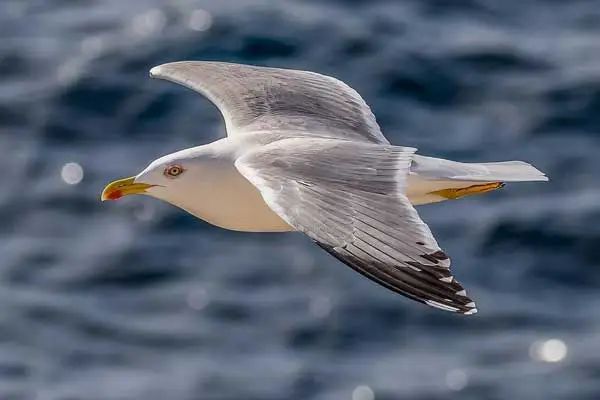
Scientific name: Larus argentatus
Lifespan: up to 50 years
Wingspan: 47-61 in
Length: 24-26 in
Weight: 2.31–3.64 lb
Range In Florida: Winter resident throughout Florida
Herring gulls are the second largest gulls found in Florida. These heavily built birds measure from 21 to 26 inches long, weigh from 1.3 to 3.6 pounds, and span up to 61 inches across the wings.
They are one of the most common and familiar gulls in Florida and can be seen around the coast and large lakes, and rivers.
Identify these large birds by their sloping foreheads, full chests, and long and powerful beaks. Adults are light gray with dark wingtips, white irises, and pink legs. Notice their massive beaks with a red spot on the lower mandible.
These birds are omnivores, primarily scavengers (like other gulls). They feed on invertebrates, fish, insects, carrion, and human refuse. Herring gulls are intelligent birds that can be often seen dropping clams and mussels from a height on hard surfaces to open them.
Common Loon
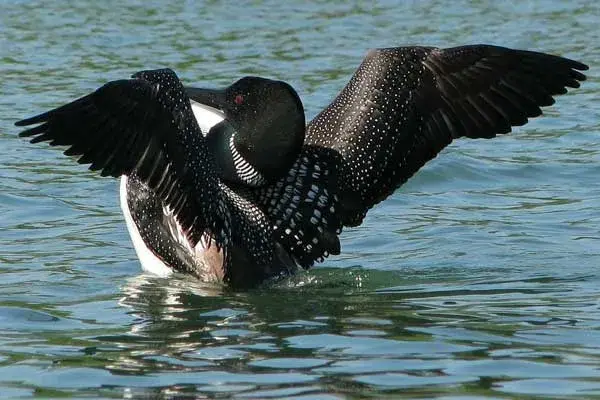
Scientific name: Gavia immer
Lifespan: 20-30 years
Wingspan: 50-57.8 in
Length: 26-36 in
Weight: 4.9-16.8 lb
Range In Florida: Winter resident throughout Florida
The common loon or the great northern diver is the largest species of loon found in Florida. It breeds in Alaska, Canada, and the northern U.S. In winter, they migrate south to winter in the coastal waters of Florida, staying there until April and early May.
This large diving waterbird is easy to spot by its rounded head and dagger-like beak. The common loon is famous for its eerie, beautiful calls (the wail, tremolo, yodel, and hoot).
During summer, adults have black heads and bills, white breast color, and black-and-white spots on their backs. By the time these loons reach Florida, the dramatic black and white colors will change into a winter plumage of dull dark gray with white on the front of the neck and breast.
Common loons are excellent divers that can stealthily submerge without a splash to catch fish. They can go over 200 feet below the water’s surface, stay there for up to 5 minutes, and swallow their prey underwater.
Common loons mostly feed on fish, crustaceans, insect larvae, mollusks, and occasionally aquatic plants.
They are monogamous and the pair may breed together for a decade or more. Both the male and the female will often together defend a territory.
The common loon is a state bird of Minnesota and a provincial bird of Ontario (Canada).
Osprey

Scientific name: Pandion haliaetus
Lifespan: 15-20 years
Wingspan: 50–71 in
Length: 19.7-26 in
Weight: 2-4.6 lb
Range In Florida: Year-round resident throughout Florida
Ospreys are very large birds found year-round throughout Florida. Some of the osprey populations found there might migrate to South America. In the state, their habitat includes the coast, lakes, rivers, and swamps.
Ospreys are large birds of prey reaching 26 inches in length and 71 inches across the wings. They have brown upperparts and predominantly greyish-white heads and underparts.
What is unusual for ospreys is that they have a reversible outer toe that allows them to grasp with two toes in front and two behind.
They are also known as “sea hawks” or “fish hawks” and will hover above the water, locate their prey and then swoop down for the capture with their talons extended. Ospreys are piscivorous and fish makes up 99% of their diet.
In Florida, ospreys will hunt saltwater catfish, mullet, spotted trout, shad, crappie, and sunfish from coastal habitats and freshwater lakes and rivers.
In south Florida, they will nest around December; in north Florida, this happens in late February. The incubation and nestling period extends into the summer months.
During their 20-year-long lifetime, these migratory birds can travel over 160,000 miles.
Black Vulture

Scientific name: Coragyps atratus
Lifespan: 10 years in the wild (up to 25 years)
Wingspan: 52-66 in
Length: 22–29 in
Weight: 3.5-6.6 lb
Range In Florida: Year-round resident throughout Florida
The black vulture, also known as the American black vulture, is a large raptor. It has a sooty black plumage, a bare black head, and white wingtips. It can be found in forests and open areas of southeastern United States, Mexico, Central, and South America.
In Florida, this large bird is a year-round resident.
The black vulture is often mistaken for the turkey vulture – the black vulture is a bit smaller, has shorter wings and tail, and the wings have white wing patches (stars).
Black vultures are monogamous and pairs are believed to mate for life – both the male and female will take turns incubating their eggs.
They are very aggressive so other vulture species tend to avoid them.
They are also carnivores that feed on carrion but may also hunt and eat small reptiles, birds, and mammals.
To escape from danger, black vultures might regurgitate partially digested food, to distract the attacker and become lighter before flying away.
Black vultures are a bit smaller than the roseate spoonbills but have a lot bigger wingspan which puts them ahead on the list of Florida’s largest birds.
Great Black-backed Gull

Scientific name: Larus marinus
Lifespan: up to 27 years
Wingspan: 59-66.9 in
Length: 25–31 in
Weight: 1.65-5 lb
Range In Florida: Winter resident in coastal parts of Florida
Described as “the king of the Atlantic waterfront”, great black-backed gulls are very aggressive hunters, pirates, and scavengers.
They are the largest gulls in Florida and the world. Great black-backed gulls are present all year in most parts of their northern breeding range and when the winter comes, some populations will move south as far as Florida.
If you live in coastal parts of Florida, you will recognize these gulls by their white heads, necks and underparts, dark grey wings and backs, pink legs, and yellow beaks.
Because of their enormous size and omnivorous feeding habits, these birds will prey on other birds during the nesting season.
Great black-backed gulls feed on carrion, fish, mollusks, crustaceans, marine worms, insects, rodents, and berries. These apex predators will also eat adults, young, and eggs of other birds.
Great black-backed gulls were hunted for their feathers that were used to make hats. As a result, this species got eradicated from large parts of its range.
Today, however, due to their adaptability to humans, the great black-backed gulls increased in numbers and became widespread – in some areas they are now even considered to be pest species.
Masked Booby
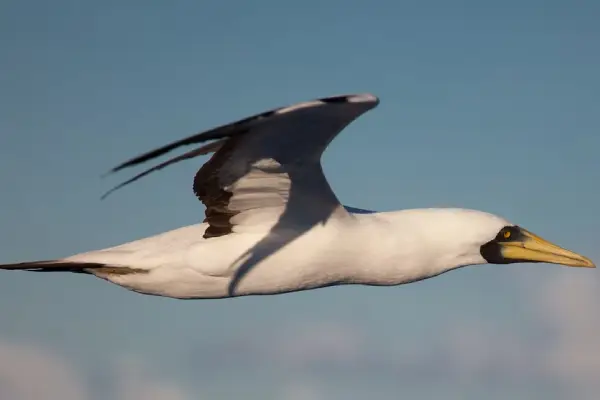
Scientific Name: Sula dactylatra
Lifespan: n/a
Wingspan: 63-67 in
Length: 30-33 in
Weight: 2.6-4.9 lb
Range In Florida: Winter resident along the southern coast of Florida
The masked booby, also known as the masked gannet, is a large seabird with a long neck and wings, a pointed tail, and a large beak. Adults are bright white and have black wings, facial masks, and tails.
With a length of up to 2 ft 9 in, they are the largest booby species in the world and can be seen in Florida. They live out at sea but you might spot them if you visit Florida’s Dry Tortugas islands.
They are very social birds that breed in colonies found on remote islands, atolls, and cays. Although quiet at sea, masked boobies get very vocal around nesting grounds. The main call males make is a descending whistle; females make loud honks.
The name “booby” comes from the Spanish word “bobo” meaning fool, most likely due to their “clumsy” courtship dances. The masked booby is a carnivore and its diet mainly consists of fish, but also some squid.
These big white birds nest in shallow holes in the ground, lay 1-2 eggs, and decorate their nests. One study found a large masked booby nest with 988 pieces of small stone or coral, 155 fragments of shell, 10 pieces of avian skeletal material, and one small piece of wood!
Turkey Vulture
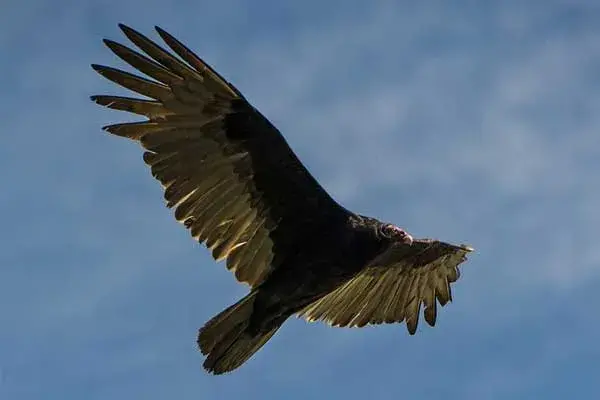
Scientific name: Cathartes aura
Lifespan: 16 years in the wild
Wingspan: 63–72 in
Length: 24–32 in
Weight: 1.8-5.3 lb
Range In Florida: Year-round resident throughout Florida
The most widespread of the New World vultures and the largest vulture in Florida, the turkey vulture got its name due to its resemblance to a wild turkey.
Turkey vultures are a familiar sight in the sky over the entire state. You will recognize them by their bald heads, dark plumage, and long, broad wings. These birds have an impressive wingspan of around 67.5 in and are bigger than other raptors, except eagles and condors.
They have a huge range and an estimated population of over 18 million birds. Look for them in the open areas including mixed farmland, forest, and rangeland.
Turkey vultures are very social birds that roost in large community groups that can include several hundred vultures, even the black ones.
They have extremely strong stomach acids which allow them to eat and digest carcasses tainted with anthrax, tuberculosis, and rabies, without getting sick.
Their diet mostly includes carrion and human garbage located through the use of smell, although they might occasionally catch live prey, including young or sick birds and mammals.
Great Egret
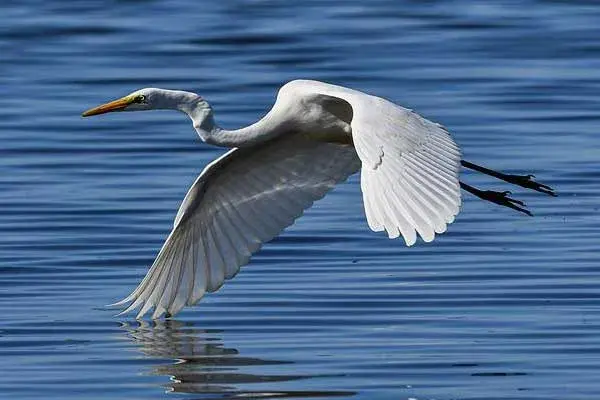
Scientific name: Ardea alba
Lifespan: 22 years
Wingspan: 52-67 in
Length: 31-41 in
Weight: 1.5-3.3 lb
Range In Florida: Year-round resident throughout Florida
This impressively large bird has a huge wingspan of up to 67 inches and can be found throughout the year in Florida, around wetlands and other areas of water.
Great egrets are one of the biggest birds found in the state and are easy to recognize by their all-white plumage, long yellowish-orange beaks, and long black legs.
Hunted for their beautiful plumes called “aigrettes” that were used as hat decoration in the 19th century, great egrets almost became extinct. Thanks to several laws and conservational measures, their numbers have since recovered.
Similar to pelicans because of their white plumage, great egrets can also tuck their necks right into their backs during flight.
They are seasonally monogamous (stay with the same partner for one breeding season) and breed in colonies in trees close to large lakes.
To attract a female, a male great egret will display its mating season plumage and colors and point its beak upward. In Florida, breeding might happen year-round, but it’s most common from May to August.
Great egrets will slowly stalk their prey or stay motionless, waiting for the right moment to strike and impale prey with their long, sharp bills. They forage in shallow water or drier habitats and mostly feed on fish, frogs, small mammals, small reptiles, crustaceans, and insects.
Northern Gannet

Scientific name: Morus bassanus
Lifespan: up to 26 years
Wingspan: 67-71 in
Length: 34.2-39.3 in
Weight: 5-8 lb
Range In Florida: Winter resident along the Florida coast
Northern gannets are the largest species of the gannet family found in Florida. Adults measure from 34 to 39 inches long and have a massive wingspan of up to 71 inches.
These huge birds are mostly white with dark wingtips and cream-colored heads and necks – that color becomes more prominent during the breeding season. Identify them also by their long pointed beaks, wings, and tails.
They spend most of their life at sea, but close to the land which means you will be able to spot them from the Florida shores. They have an interesting way of hunting where they dive like a torpedo into the water to grab fish. Thanks to their sharp vision, northern gannets can detect prey underwater, and due to their eye adaptations, they can see well immediately after going underwater.
They are mostly found in large feeding groups and have a harsh “arrah-arrah” call.
Wood Stork
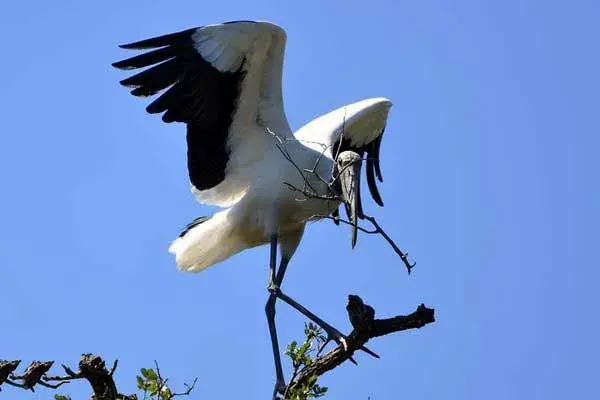
Scientific name: Mycteria americana
Lifespan: up to 27 years
Wingspan: 55–71 in
Length: 33.5-45.3 in
Weight: 4.4-5.8 lb
Range In Florida: Year-round resident throughout Florida
The wood stork is one of the largest wading birds in Florida and the only stork regularly found in the United States. This huge and heavy-billed bird can be seen wading in the mixed hardwood swamps, sloughs, mangroves, and cypress domes/strands of Florida.
It is a year-round resident found throughout the state that breeds during the late winter dry season. Wood storks are easy to recognize by naked dark gray heads and necks, white plumage with black-edged wings and tails, long legs, and long, slightly curved black bills.
Wood storks are listed as threatened in the US. After three-decade-long conservation and recovery efforts, the species moved from endangered to threatened species in June 2014.
They were once more abundant in the wetlands of south Florida than in any other region throughout the southeastern states, because they prefer tropical and subtropical habitats with distinct wet and dry seasons.
Wood storks are very social birds that feed in flocks and nest in large rookeries – sometimes with several pairs on a single tree.
They build large stick nests in the trees, the female will lay two to five eggs, and both of the parents will take turns incubating them for about one month. To keep their nestlings cool, wood storks will regurgitate water over them.
This stork might not bring babies, but it is still one of the biggest native birds of Florida.
Sandhill Crane
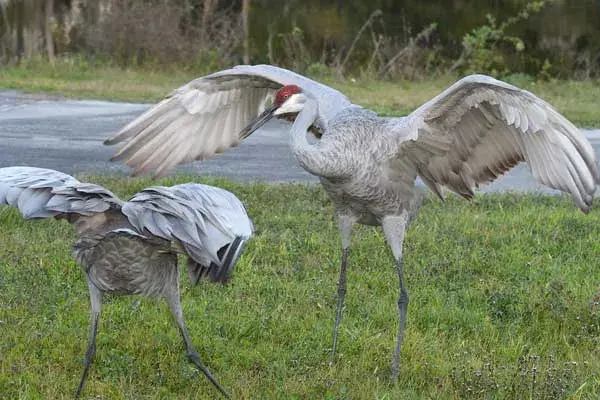
Scientific name: Grus canadensis
Lifespan: 20 years
Wingspan: 78.7 in
Length: 47.2 in
Weight: 6-14.8 lb
Range In Florida: Winter resident in southern parts and year-round resident in northeastern parts of Florida
Sandhill cranes are very large, tall birds with long necks and legs, and very broad wings. These large birds in Florida with red heads have a truly unique look.
Sandhill cranes can be identified by their mostly slate gray plumage, rusty washes on the upperparts, pale cheeks in adults, red head patches, and black legs.
Florida is home to two subspecies of sandhill cranes: the Greater Sandhill Crane which migrates to Florida from the north and winters in Florida’s prairies and wetlands, and the Lesser Sandhill Crane, now known as the Florida Sandhill Crane, which is a year-round resident of the northeastern parts of the peninsula.
Of the many giant birds in Florida, sandhill cranes are also one of the most striking. With a wingspan of almost 7 feet, a height of 4 feet, and an average weight of 10 pounds, these beautiful birds are just slightly smaller than their endangered cousin, the whooping crane.
Sandhill cranes are fairly social birds and can be usually found in pairs or family groups throughout the year. They are also monogamous and mate for life, staying together for years, until one of the cranes dies.
Their diet mostly consists of plant material, including waste grain, roots, berries, nuts, some insects, and snails.
Bald Eagle

Scientific name: Haliaeetus leucocephalus
Lifespan: 20-30 years in the wild
Wingspan: 70.8-90.5 in
Length: 28-40 in
Weight: 6.6-13.9 lb
Range In Florida: Year-round resident throughout Florida
One of the largest and most iconic birds of North America, the bald eagle is a bird of prey easily recognized by its commanding presence, white head and tail, brown plumage, and bright yellow beak.
This enormous bird can be found throughout the year in Florida. During winter, they may flock together in large numbers.
Florida has one of the densest concentrations of nesting bald eagles in the lower 48 states, with an estimated 1,500 nesting pairs.
Bald eagles are common around large bodies of open water with an abundant food supply and old-growth trees for nesting.
They are carnivores and opportunistic feeders that mostly consume fish, which they snatch from the water with their talons.
These birds are hard to miss as they soar through the air with their 7.5-foot-wide wingspan.
Bald eagles build the largest nests of any North American bird and the largest tree nests ever recorded for any animal species. Their nests can be up to 13 ft deep and 8.2 ft wide.
Want to see what some of the smallest Floridian birds look like? Click here.
Great Blue Heron
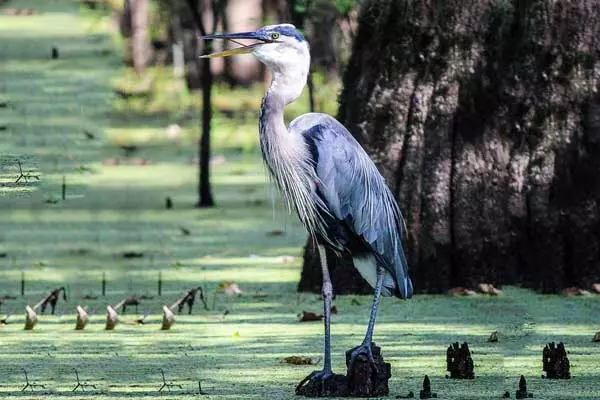
Scientific name: Ardea herodias
Lifespan: 15 years
Wingspan: 66–79 in
Length: 36–54 in
Weight: 4.0-7.9 lb
Range In Florida: Year-round resident throughout Florida
The largest of North American herons and one of Florida’s largest birds, the great blue heron is easy to identify by its large yellow-orange bill, short black plumes on its head, and black and chestnut pattern on the shoulders.
In south Florida and the Florida Keys, there is a large all-white subspecies of great blue herons known as the great white heron. They are the largest subspecies of great blue herons.
Great blue herons are quite common near the shores of open water and in wetlands. During the flight, they will hold their necks in an S-shape with legs trailing behind.
Despite their large size and stocky build, great blue herons are fast birds that can reach speeds of around 30 mph.
They are monogamous only for a single season and will go through some interesting courtship rituals, locking and rubbing their bills on the feathers of the other bird before mating. Both parents will take turns in incubating the eggs, and after hatching, the chicks can fly at only 2 months of age.
They nest in colonies called heronries that can occasionally have more than 500 nests.
Great blue herons are carnivores that feed on fish, amphibians, reptiles, invertebrates, small mammals, and even other birds.
These birds will slowly stalk their prey in shallow waters, striking with lightning speed, catching them with their long and sharp beaks.
Read More: 14 birds in Pennsylvania that are blue
Magnificent Frigatebird

Scientific name: Fregata magnificens
Lifespan: 14-30 years
Wingspan: 85.4-96 in
Length: 35-44.8 in
Weight: 2.4-3.5 lb
Range In Florida: Year-round resident of southern Florida and summer resident in northern Florida
In North America, magnificent frigatebirds are most commonly found in Florida. Some populations of this bird will stay the entire year in southern parts of the state, while others will come to northern parts only during summer.
Rightfully named due to their striking appearance and behavior, magnificent frigatebirds are easily recognizable even at long distances.
They have a huge size, long pointed wings, and long deeply forked tails. Males have a striking red gular sac which they inflate to attract slightly larger females.
Magnificent frigatebirds are the largest species of frigatebird in Florida.
They mostly feed on fish taken in flight from the ocean’s surface and their favorite food is flying fish, tuna, and squid.
Magnificent frigatebirds will sometimes steal fish from other animals by harassing and forcing them to regurgitate their meal. They will then delicately swoop down, catching this regurgitation before it hits the water. This is known as kleptoparasitism.
Despite their massive wingspan of 7 to 8 feet, these birds can’t land on water as their feathers aren’t waterproof and they would most likely drown.
Read More: Largest birds of Colorado!
Whooping Crane
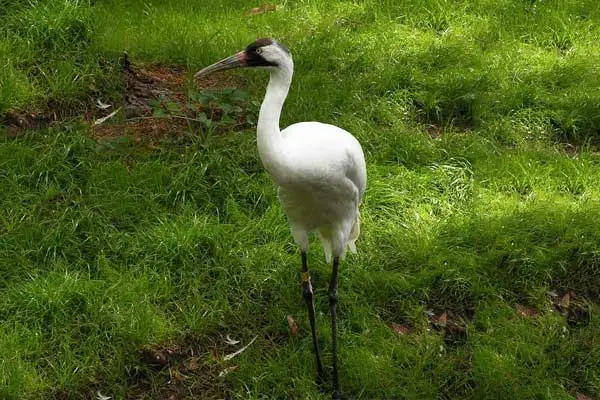
Scientific name: Grus americana
Lifespan: 22-24 years in the wild
Wingspan: 79-90 in
Length: 52 in
Weight: 9.9-18.7 lb
Range In Florida: Year-round resident in Central Florida
Named for its whooping sound, the whooping crane is the tallest bird in Florida (and North America). This bird is going to leave you stunned with its snowy white plumage, crimson cap, bugling call, and graceful courtship dance.
Whooping cranes are the third-largest birds in Florida with an impressive wingspan of up to 7 ft 7 in, a weight of up to almost 19 pounds, and a height of up to 5 ft 3 in.
They are also easy to identify by the red skin patches on their forehead, black “mustache” and legs, and black wing tips that are visible in flight.
It is an endangered crane species that had a population of around 20 birds in the 1940s. In recent years, thanks to strong conservation efforts, the total number of whooping cranes has now exceeded 800 birds.
These birds live and breed in wetland areas, where they feed on crabs, clams, frogs, and aquatic plants.
In Central Florida, there is a non-migratory whooping crane population that the Florida Fish and Wildlife Conservation Commission (FWC) introduced in 1993. They breed in the state between January and May, having a clutch size of one to three eggs. Both parents will incubate the eggs.
Whooping cranes have many predators, including black bears, wolves, foxes, coyotes, and eagles.
They are just one of many on our list of the biggest white birds in the world.
Brown Pelican

Scientific name: Pelecanus occidentalis
Lifespan: 20-40 years
Wingspan: 80-90 in
Length: 39.4-60 in
Weight: 4.4-11 lbs
Range In Florida: Year-round resident along the coast of Florida
One of the most iconic sights of Florida shores is seeing a group of these large, distinctive birds, silently gliding up or down the coastline with an occasional beat of their strong wings.
Brown pelicans are the second largest species of pelicans found in Florida. More common than the American White one, these elegant birds have oversized beaks (13 inches long), sinuous necks, and big, dark bodies.
You will easily identify brown pelicans by their size, chestnut-and-white necks, white-colored heads with pale yellow crowns, brown-streaked backs, rumps, and tails, and black legs and feet.
One of Florida’s most conspicuous and popular birds, brown pelicans can be seen just about everywhere along Florida’s coastline. However, it wasn’t always that way.
In the 20th century, people were hunting brown pelicans heavily for their plumage. So in 1903, USA president Theodore Roosevelt established Pelican Island near Sebastian in Indian River County to protect the species.
Brown pelicans have an extendable sac of skin that hangs below their long, lower beak. This pouch can hold up to 3 gallons of water, three times more than their belly.
They use their pouches to catch fish and also to cold down, by evaporating water off the skin surface.
Brown pelicans will fly 70 feet over the ocean, with necks folded backward and their heads resting on their backs, looking for fish in the water. When they spot their prey, pelicans will dive down and collect as much fish with their pouches as possible, along with lots of water.
They will squeeze the water out and just swallow the trapped fish. Pelicans need to eat up to four pounds of fish (and perhaps some shrimp) per day to survive. They will even dive as deep as 30 feet to catch prey.
In South Florida, nesting season begins in the fall; in central and northern Florida, it’s in early spring.
Brown pelicans are monogamous for a single season, and after mating, the pair will build their nest either on the ground or in trees. Males will bring the building material and the female will build the nest. Usually, a female will lay from one to four eggs per season.
Read More: Big red birds – photos and fun facts
American White Pelican

Scientific name: Pelecanus erythrorhynchos
Lifespan: 16-30 years
Wingspan: 95-120 in
Length: 50–70 in
Weight: 11-20 lb
Range In Florida: Winter resident throughout Florida
The American white pelican is a large aquatic bird that lives in inland shallow freshwater lakes, wet prairies, and marshes in the summer, and on coastal lagoons in the winter.
It has white plumage and black flight feathers visible only when the wings are spread. American pelican also has a vivid yellow-orange bill and legs. White pelicans have the largest beak of any other North American waterbird, measuring 11.3–15.2 inches in males and 10.3–14.2 inches in females.
With a wingspan of up to 120 in, American white pelicans are the largest birds in Florida and can weigh as much as 30 pounds, although typically they average between 11 and 20 lb.
Unlike brown pelicans, which are year-round Florida residents, American white pelicans migrate to Florida to spend the winter there.
You will see them arriving in the state from early September to late November. Around March, white pelicans will move north to breed in the northern part of the Western USA and Canada.
Their diet mostly consists of fish, but also some crayfish and salamanders.
A group of pelicans is called a “brief” and a “squadron”.
Read More: 15 green birds found in Florida
Summary
This concludes our list of big birds in Florida.
There are several types of large birds in Florida, including several types of pelicans, cranes, eagles, owls, vultures, storks, and gulls.
Florida, just like Ohio, Pennsylvania, and Illinois, has large areas of different natural habitats that make great homes for a wide range of bird species.
Next time, should you see these birds in person, you should be able to recognize any of them with ease!
And if you enjoyed our article, here are our other popular reads on birds: 15 incredible blue birds of Maryland and a list of pink Florida birds
Feel free to check the links below with articles on large birds found in other US states.